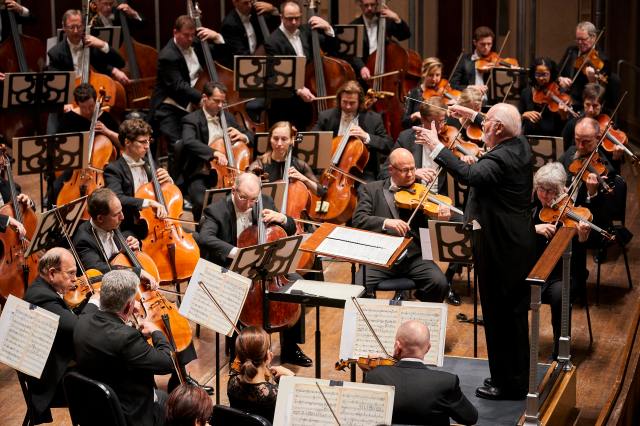Cleveland Orchestra
John Williams, conductor
Severance Hall
Cleveland, OH
April 8, 2018
Sound the Bells!
Excerpts from Close Encounters of the Third Kind
“Hedwig’s Theme”, “Nimbus 2000”, and “Harry’s Wondrous World” from Harry Potter and the Sorcerer’s Stone
“With Malice Toward None” from Lincoln
“Adventures on Earth” from E.T. the Extra-Terrestrial
“Flight to Neverland” from Hook
A Child’s Tale: Suite from The BFG
“Out to Sea” and “Shark Cage Fugue” from Jaws
Theme from Sabrina
“The Rebellion is Reborn” from Star Wars: The Last Jedi
“Rey’s Theme” from Star Wars: The Force Awakens
Main Title from Star Wars
Encores:
“Han Solo and the Princess” from The Empire Strikes Back
“The Raiders March” from Raiders of the Lost Ark
“The Imperial March” from The Empire Strikes Back
While gearing up for a trio of complete performances of Wagner’s monumental Tristan und Isolde, The Cleveland Orchestra – perhaps by design, perhaps by happy coincidence – presented two radically different programs that nonetheless both bore Wagner’s far-reaching influence: Joseph Suk’s Asrael Symphony, a work of rich (i.e. Tristan-infused) chromatic harmony, and the film scores of John Williams conducted by the composer himself, works that employ a sophisticated use of leitmotifs and scoring for massive orchestra, surely taking an unapologetic cue from late 19th-century Romanticism. Though Williams has conducted TCO on multiple occasions at Blossom, Sunday night counted as his Severance Hall debut, a venue he touchingly referred to as a “magical place.”

At 86 years old and with no less than 51 Oscar nominations to his name (second only to Walt Disney), there’s quite a sense of occasion in seeing Williams in the flesh, the performance having been sold out since August (and how often does one have the opportunity to hear a conductor lead an entire program of their own compositions?). Despite such acclaim, Williams comes across as remarkably humble and down to earth, in one of his spoken interludes between selections joking that it’s good for the vanity of a composer to present the score without the distraction of the film. The scores certainly thrived as concert music independent of their respective films, and in the hands of The Cleveland Orchestra, never have these iconic film scores sounded so good.
The evening opened with a brief but energetic fanfare in Sound the Bells!, a 1993 work written in honor of the wedding of Japan’s Crown Prince Naruhito and Crown Princess Masako – a festive affair with emphasis on the brass and titular bells. A suite from Close Encounters of the Third Kind followed with dissonant glissandos suggesting an alien landscape, with matters in due course turning heroic and quite lyrical. The magical sound of Joela Jones’ celesta was instantly recognizable as “Hedwig’s Theme” from Harry Potter and the Sorcerer’s Stone, a leitmotif that binds the music of all the films in the franchise together, even after Williams passed the baton to others. The theme was presented again in the brass, and the music took flight with rapid celesta fingerwork. “Nimbus 2000” featured some featherlight interplay in the winds, while “Harry’s Wondrous World” burst with a youthful vigor, again interpolating the Hedwig motif.
Principal trumpet Michael Sachs has an association with Williams dating back to at least 1996 when he premiered Williams’ Trumpet Concerto, and was thus an ideal choice to deliver the solo part of “With Malice Towards None” from Lincoln. His clarion and stately playing beautifully captured the president’s grace and seriousness of purpose. The first half closed with what Williams referred to as the “last reel” of E.T., essentially a ten-minute tone poem. A graceful theme rose higher and higher as if leaving the Earth, depicting that classic scene of the bicycle flying past the moon.
“Flight to Neverland” from Hook was bold and brassy, the textures dense but never muddled. Scoring for harp and celesta gave the suite from The BFG a fantastical, dreamy quality, and a flute solo from Joshua Smith suggested a certain innocence, countered by more sinister material. Two excerpts from Jaws followed, although neither contained the famous half-step gesture. “Out to Sea” had a nonchalance, unaware of the dangers awaiting, while “Shark Cage Fugue” was dark and dramatic, as impressive a display of contrapuntal mastery as any. Concertmaster William Preucil served as another featured soloist in the Theme from Sabrina, a 1995 remake of the 1954 film starring Audrey Hepburn, to whom Williams dedicated the performance. Preucil’s solo was lush and lovely, and the music clearly came from the same pen as Schindler’s List, evidencing Williams’ more subtle side, aided and abetted by gentle touches on the piano and harp.
Inevitably, the program closed with music from Star Wars, beginning with “The Rebellion is Reborn” from last year’s installment, music calculated to reinvigorate, sounding fresh even 40 years after the original film. “Rey’s Theme” furthered demonstrated Williams’ fondness for the celesta in this affecting character portrait, and the Main Title was given a powerhouse workout. Three encores were played, with additional Star Wars tracks – including a touching rendition of “Han Solo and the Princess” – framing a rousing “Raiders March” from Indiana Jones. It’s worth noting that Williams as well as the orchestra musicians donated their time for Sunday’s performance, with the evening’s proceeds going towards the musicians’ pension fund. A thoroughly enjoyable and memorable entry in The Cleveland Orchestra’s blockbuster centennial season.


